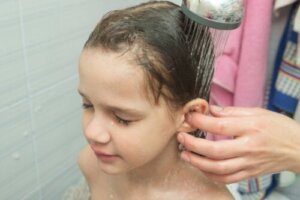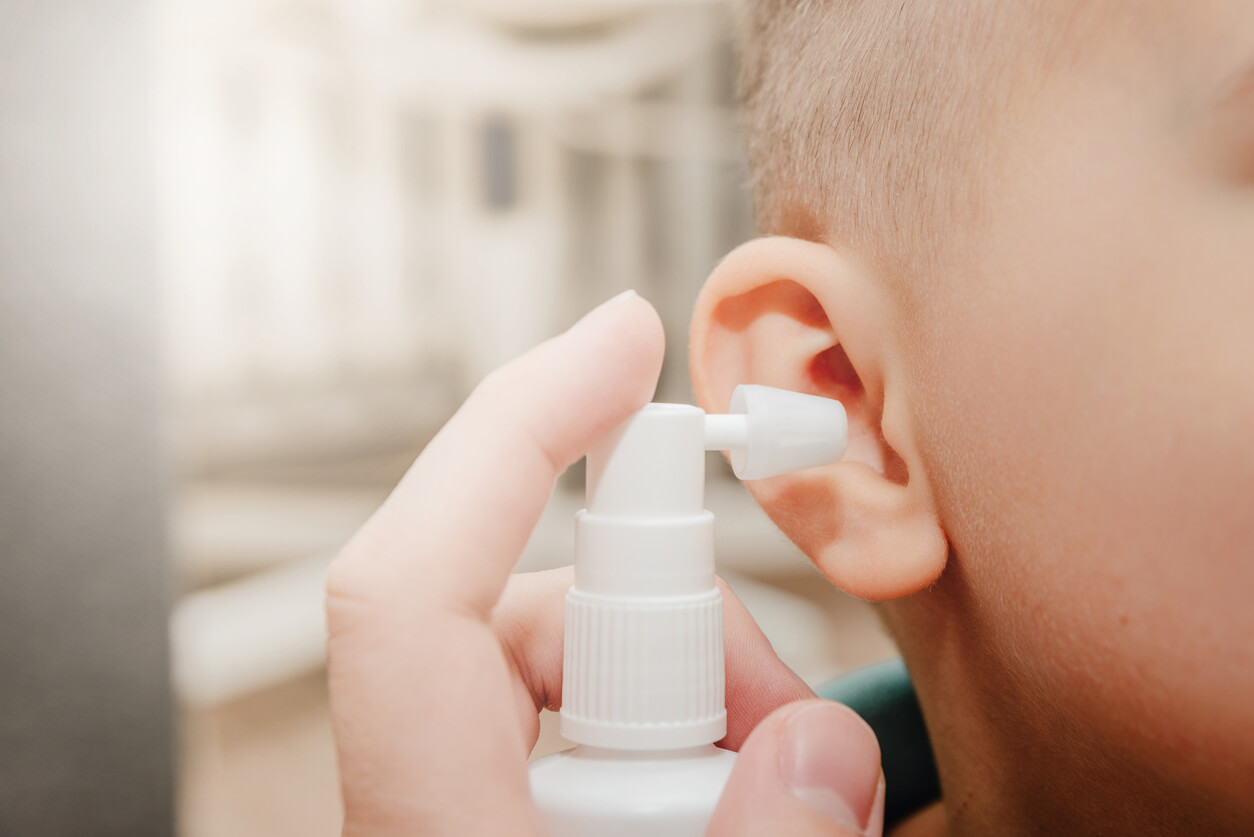10 Tricks to Teach Children to Clean Their Ears


Written and verified by the dermatologist Maria del Carmen Hernandez
Everyone has earwax in their ears, however, some parents notice it in their children and consider teaching them to clean their ears. Wax is in the ear canal to fulfill a function and prevent infections, damage from the wind or cold, or certain insects from entering.
How to teach children to clean their ears?
Wax is healthy for children’s ears, as it protects them, lubricates them, and has antibacterial properties. In addition, it contains enzymes that help prevent the growth of bacteria and fungi. It even traps dust and dirt particles that enter the ear.
1. Teach children to clean their ears as a game
One of the most enjoyable and didactic ways to teach habit-forming in children is through games. These are an important part of the learning process. Children learn in very different ways than adults, as their imagination is very much involved. Playful activities are what bring together the logical and creative parts of the brain.
2. Avoid cotton swabs
It’s not a safe procedure to use cotton swabs and insert them into children’s ears. Soft objects can rupture an eardrum or push wax further into the tympanic membrane, clumping it and blocking hearing.
You may be interested in: Why Shouldn’t You Use Cotton Swabs to Clean Your Baby’s Ears?

3. Do away with home remedies
Earwax removal with home remedies isn’t safe to do at home. There are specific cases that require the attention of a medical professional. In addition, the use of objects that must be inserted, ear candles, peroxide, heat therapies, or pastes performed at home aren’t recommended.
4. Take advantage of bath time
The best recommendation is to use only water to rinse the ears. Therefore, bath time is an ideal time to teach children how to wash their ears. If necessary, soap can be used together with warm water during bath time. However, cleaning the area shouldn’t be excessive–once a week is enough.
Read also: Doubts Before Piercing Your Baby’s Ears
5. Set an example
When children are still young, they tend to imitate everything adults do. This is a very useful resource to take advantage of when teaching. Just as you teach them how to brush their teeth by imitation, you can also do the same for rinsing and washing their ears correctly.
6. Avoid irritating methods
If you’re trying to instill a new habit and teach children to wash their ears, it’s best to create a pleasant and enjoyable moment. Therefore, avoid any type of product that may be aggressive or irritating to the child’s skin. Just soap and water will be enough to perform correct hygiene.
7. Don’t overdo hygiene
Ear wax only becomes a problem if it causes hearing impairment or other related symptoms. To prevent the deep ear canal from filling up with dead skin cells, this skin is migratory and moves outwards. That is, most of the earwax emerges from the external canal spontaneously.

8. Use wet wipes
The same wet wipes that are usually used for baby hygiene are a recommended option to make learning easier for children. These are composed of cosmetics and soap, so they’re useful for cleaning the ears. Keep in mind that they shouldn’t be introduced deeply, but only on the outside to drag away debris.
9. Dry them correctly
Although rinsing with soap and water is important to maintain the hygiene of the ears, drying them afterward is also important. This helps to avoid infections due to residual moisture or discomfort in the future. The outer parts of the ear, i.e. all regions of the pinna, should be dried. However, don’t insert the towel inside the ear canal.
10. Motivate and encourage children
A good way to teach children to clean their ears is to motivate them to do it on their own and to congratulate them when they succeed. This generates satisfaction in them and encourages them to do it again. Motivation is one of the actions that most contribute to the objective of educating children because it stimulates a positive attitude in all the actions they do during the day.
Children and ear cleaning
It’s important to explain to children, from an early age, how important it is to perform correct and regular ear hygiene. In addition, it’s important to be consistent and patient in the instruction and learning of new habits in children.
Everyone has earwax in their ears, however, some parents notice it in their children and consider teaching them to clean their ears. Wax is in the ear canal to fulfill a function and prevent infections, damage from the wind or cold, or certain insects from entering.
How to teach children to clean their ears?
Wax is healthy for children’s ears, as it protects them, lubricates them, and has antibacterial properties. In addition, it contains enzymes that help prevent the growth of bacteria and fungi. It even traps dust and dirt particles that enter the ear.
1. Teach children to clean their ears as a game
One of the most enjoyable and didactic ways to teach habit-forming in children is through games. These are an important part of the learning process. Children learn in very different ways than adults, as their imagination is very much involved. Playful activities are what bring together the logical and creative parts of the brain.
2. Avoid cotton swabs
It’s not a safe procedure to use cotton swabs and insert them into children’s ears. Soft objects can rupture an eardrum or push wax further into the tympanic membrane, clumping it and blocking hearing.
You may be interested in: Why Shouldn’t You Use Cotton Swabs to Clean Your Baby’s Ears?

3. Do away with home remedies
Earwax removal with home remedies isn’t safe to do at home. There are specific cases that require the attention of a medical professional. In addition, the use of objects that must be inserted, ear candles, peroxide, heat therapies, or pastes performed at home aren’t recommended.
4. Take advantage of bath time
The best recommendation is to use only water to rinse the ears. Therefore, bath time is an ideal time to teach children how to wash their ears. If necessary, soap can be used together with warm water during bath time. However, cleaning the area shouldn’t be excessive–once a week is enough.
Read also: Doubts Before Piercing Your Baby’s Ears
5. Set an example
When children are still young, they tend to imitate everything adults do. This is a very useful resource to take advantage of when teaching. Just as you teach them how to brush their teeth by imitation, you can also do the same for rinsing and washing their ears correctly.
6. Avoid irritating methods
If you’re trying to instill a new habit and teach children to wash their ears, it’s best to create a pleasant and enjoyable moment. Therefore, avoid any type of product that may be aggressive or irritating to the child’s skin. Just soap and water will be enough to perform correct hygiene.
7. Don’t overdo hygiene
Ear wax only becomes a problem if it causes hearing impairment or other related symptoms. To prevent the deep ear canal from filling up with dead skin cells, this skin is migratory and moves outwards. That is, most of the earwax emerges from the external canal spontaneously.

8. Use wet wipes
The same wet wipes that are usually used for baby hygiene are a recommended option to make learning easier for children. These are composed of cosmetics and soap, so they’re useful for cleaning the ears. Keep in mind that they shouldn’t be introduced deeply, but only on the outside to drag away debris.
9. Dry them correctly
Although rinsing with soap and water is important to maintain the hygiene of the ears, drying them afterward is also important. This helps to avoid infections due to residual moisture or discomfort in the future. The outer parts of the ear, i.e. all regions of the pinna, should be dried. However, don’t insert the towel inside the ear canal.
10. Motivate and encourage children
A good way to teach children to clean their ears is to motivate them to do it on their own and to congratulate them when they succeed. This generates satisfaction in them and encourages them to do it again. Motivation is one of the actions that most contribute to the objective of educating children because it stimulates a positive attitude in all the actions they do during the day.
Children and ear cleaning
It’s important to explain to children, from an early age, how important it is to perform correct and regular ear hygiene. In addition, it’s important to be consistent and patient in the instruction and learning of new habits in children.
All cited sources were thoroughly reviewed by our team to ensure their quality, reliability, currency, and validity. The bibliography of this article was considered reliable and of academic or scientific accuracy.
- Aaron K, Cooper TE, Warner L, Burton MJ. Ear drops for the removal of ear wax. Cochrane Database Syst Rev. 2018 Jul 25;7(7):CD012171. doi: 10.1002/14651858.CD012171.pub2. PMID: 30043448; PMCID: PMC6492540.
- Clegg AJ, Loveman E, Gospodarevskaya E, Harris P, Bird A, Bryant J, Scott DA, Davidson P, Little P, Coppin R. The safety and effectiveness of different methods of earwax removal: a systematic review and economic evaluation. Health Technol Assess. 2010 Jun;14(28):1-192. doi: 10.3310/hta14280. PMID: 20546687.
-
Centro Nacional de Directrices (Reino Unido). Hipoacusia en adultos: evaluación y manejo. Londres: Instituto Nacional de Excelencia en Salud y Atención (Reino Unido); Junio de 2018 (Directriz NICE, No. 98.) 10, Manejo de cerumen. Disponible en: https://www.ncbi.nlm.nih.gov/books/NBK536541/
This text is provided for informational purposes only and does not replace consultation with a professional. If in doubt, consult your specialist.








